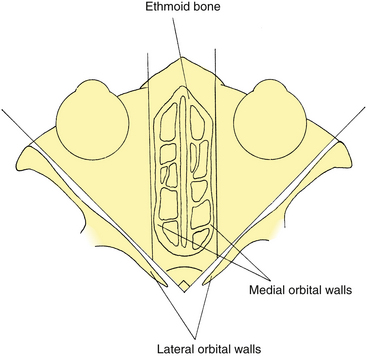Chapter 8 Bones of the Skull and Orbit
Bones of the Cranium
The paired parietal bones form the roof and sides of the cranium (Figure 8-1). The parietal bones articulate with each other at the midline in the sagittal suture, with the occipital bone posteriorly in the lambdoid suture, and with the frontal bone anteriorly at the coronal suture. The parietal bone articulates inferiorly with the temporal bone and the greater wing of the sphenoid bone.
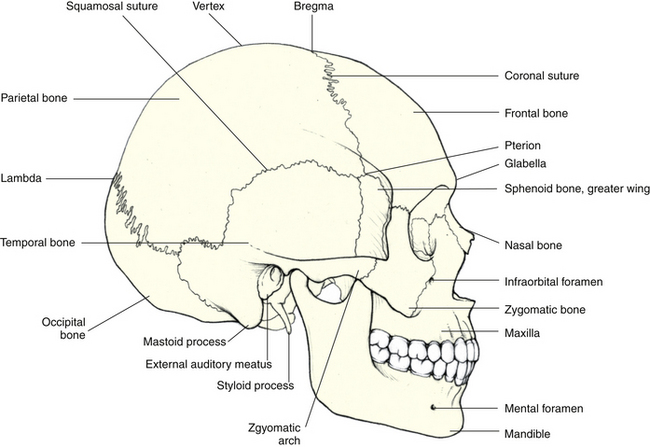
FIGURE 8-1 Lateral view of skull.
(From Mathers LH, Chase RA, Dolph J et al: Clinical anatomy principles, St Louis, 1996, Mosby.)
The occipital bone forms the posterior aspect of the skull and posterior floor of the cranial cavity. A prominence, the external occipital protuberance, or inion, is found on the external surface at the posterior midline (Figure 8-2). The large foramen magnum is found in the inferior aspect of the occipital bone. The inner surface of the bone forms the posterior cranial fossa, in which there are depressions where the lobes of the cerebellum lie. Figure 8-3 shows the inner aspect of the cranial floor. The occipital bone articulates with the temporal bones, parietal bones, and sphenoid bone.
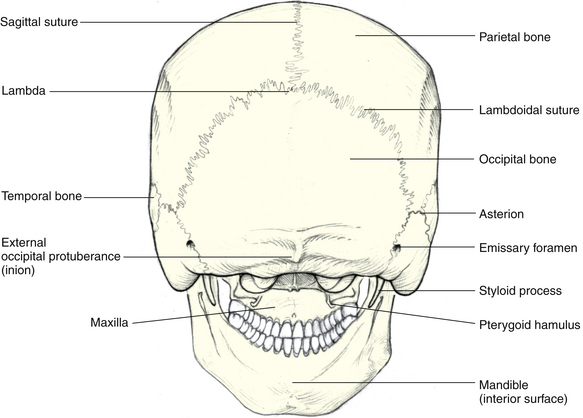
FIGURE 8-2 Posterior view of skull.
(From Mathers LH, Chase RA, Dolph J, et al: Clinical anatomy principles, St Louis, 1996, Mosby.)
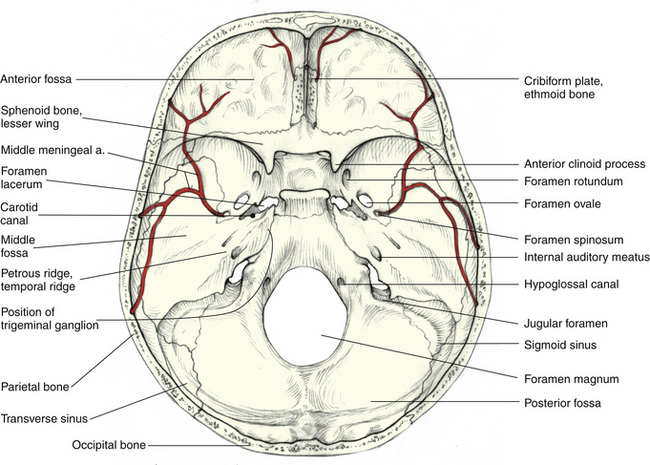
FIGURE 8-3 Floor of skull.
(From Mathers LH, Chase RA, Dolph J, et al: Clinical anatomy principles, St Louis, 1996, Mosby.)
Bones of the Face
The single frontal bone forms the forehead and articulates with the nasal bones, maxillae, and zygomatic bones in formation of the face (see Figure 8-4). The sutures joining adjacent bones of the face generally are named according to the names of the two bones that are connected (e.g., the suture between the frontal bone and the zygomatic bone is the frontozygomatic suture).
The two maxillae, or maxillary bones, form the upper jaw, the hard palate, the lateral walls of the nasal cavity, and the floor of both orbits (see Figure 8-4). Each maxillary bone articulates with the frontal, nasal, lacrimal, ethmoid, sphenoid, palatine, and zygomatic bones. That portion of the maxillary bone forming the cheek contains the maxillary sinus.
Each of the temporal bones is composed of two portions: a large, flat plate, the squamous portion; and a thickened, wedge-shaped area, the petrous portion. The squamous portion forms the side of the cranium and articulates with the parietal bone and the sphenoid bone. An anterior projection, the zygomatic process, articulates with the zygomatic bone (see Figure 8-1). The petrous portion extends within the cranium and houses the middle and inner ear structures. The mastoid process and styloid process project from the inferior aspect, and between these two processes is the stylomastoid foramen, through which the facial nerve exits the skull. The petrous portion articulates with the occipital bone in the floor of the skull. The carotid canal runs superiorly and anteriorly through the petrous portion and provides an entrance for the internal carotid artery into the cranial cavity (Figure 8-3).
The single frontal bone forms the anterior portion of the cranium, anterior floor of the cranial cavity, and superior part of the face (Figure 8-4). At the top of the skull, the frontal bone articulates with the parietal bones; inferiorly it articulates with the sphenoid bone, ethmoid bone, and lacrimal bones. Inferoanteriorly, it articulates with the nasal bones, maxillary bones, and zygomatic bones. The inner surface of the cranial cavity portion of the frontal bone forms the anterior cranial fossa (see Figure 8-3), in which the frontal lobes of the cerebral hemispheres lie. The frontal sinuses are located within the anterior portion of the frontal bone.

FIGURE 8-4 Anterior view of skull.
(From Mathers LH, Chase RA, Dolph J, et al: Clinical anatomy principles, St Louis, 1996, Mosby.)
The sphenoid bone is a single bone, the body of which lies in the midline and articulates with the occipital bone and the temporal bones to form the base of the cranium (see Figure 8-3). The sphenoid bone joins the zygomatic bones to form the lateral walls of the orbits. Anteriorly and inferiorly the sphenoid bone articulates with the maxillary and palatine bones, superiorly with the parietal bones, and anteriorly and superiorly with the ethmoid and frontal bones. The depression on the superior cranial surface of the body of the sphenoid bone, the hypophyseal fossa (or the sella turcica), houses the pituitary gland; a portion of the body is hollow, forming the sphenoid sinus cavity.
Two pairs of wings project from the body of the sphenoid bone. The lesser wings project from the anterior aspect of the body and are more superior and smaller than the greater wings (see Figure 8-3). The lesser wings are attached to the body by small roots or struts. The gap between the lesser wing and the sphenoid body forms the optic foramen (canal) through which the optic nerve exits the orbit. The lesser wings articulate with the frontal and ethmoid bones.
The greater wings project from the lateral aspects of the body and articulate with the frontal bone, the parietal bones, squamous portions of the temporal bones, and the zygomatic bones. The pterygoid process projects from the base of the greater wing and articulates with the vertical stem of the palatine bone; each contributes to a shallow depression, the pterygopalatine fossa. Three important foramina are located in the greater wing (Figure 8-5): the foramen rotundum, through which the maxillary nerve passes; the foramen ovale, through which the mandibular nerve passes; and the foramen spinosum, through which the middle meningeal artery passes.
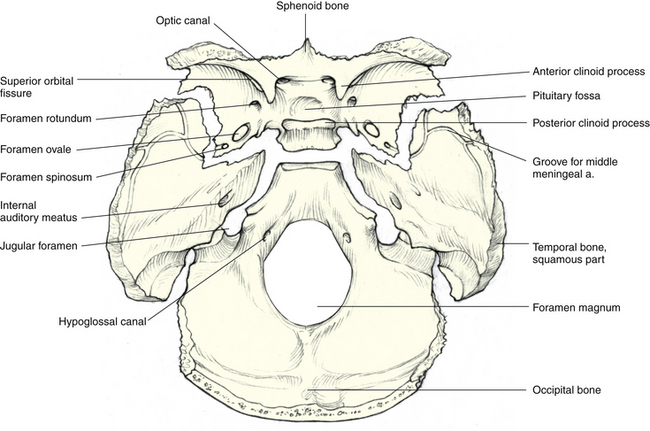
FIGURE 8-5 Disarticulated view of base of skull.
(From Mathers LH, Chase RA, Dolph J, et al: Clinical anatomy principles, St Louis, 1996, Mosby.)
The two nasal bones form the bridge of the nose and articulate with each other, with the frontal bone, and with the frontal processes of the maxillary bones (see Figure 8-4). The vomer is a single bone that forms the posterior part of the nasal septum. It articulates with the palatine and maxillary bones inferiorly and with the ethmoid bone superiorly. The inferior conchae are separate bones located along the lateral walls of the nasal cavity.
The paired zygomatic bones form the lateral part of the cheekbones and articulate with the zygomatic process of the temporal bones to form the zygomatic arches (see Figure 8-1). The zygomatic bones also articulate with the maxillary bones and with the greater wings of the sphenoid bone.
The Orbit
The orbit is shaped like a four-sided pyramid, the base of which is at the anterior orbital margin and the apex at the posterior margin within the skull. The orbital walls are referred to as the roof, floor, and medial and lateral walls. The medial walls run approximately parallel to each other, whereas the two lateral walls, if extended posteriorly, would form approximately a 90-degree angle with each other1,2 (Figure 8-6). The orbit has also been described as pear shaped, having its widest portion 1.5 cm inside the orbital margin.1 The orbital floor extends to approximately two-thirds the depth of the orbit; the other three sides extend to the apex.
Each orbit is composed of seven bones—the frontal, maxillary, zygomatic, sphenoid, ethmoid, palatine, and lacrimal bones (Figure 8-7). The frontal, sphenoid, and ethmoid are each a single bone and take part in the formation of both orbits.

FIGURE 8-7 Anterior view of bones of orbit.
(From Mathers LH, Chase RA, Dolph J, et al: Clinical anatomy principles, St Louis, 1996, Mosby.)
Orbital Walls
Roof
The roof is triangular and is composed primarily of the orbital plate of the frontal bone in front (Figure 8-8). The lesser wing of the sphenoid contributes a small posterior portion. The orbital plate of the frontal bone is thin in the area that separates the orbit from the anterior cranial fossa. In an elderly adult, bone in this area may resorb, leaving only the periosteal connective tissue in contact with the dural covering of the frontal lobe of the brain. The small area of the lesser wing of the sphenoid that is involved in this wall runs slightly downward, and an oval foramen, the optic canal, lies between it and the body of the sphenoid (see Figure 8-7). This optic foramen is located roughly at the apex of the orbit.
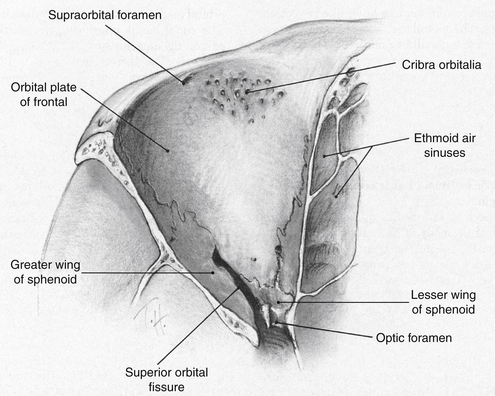
FIGURE 8-8 Bones of orbital roof.
(From Doxanas MT, Anderson RL: Clinical orbital anatomy, Baltimore, 1984, Williams & Wilkins.)
Floor
The floor is also triangular and is composed of the orbital plate of the maxillary bone and the orbital plate of the zygomatic bone in front and the small orbital process of the palatine bone behind (Figure 8-9
Stay updated, free articles. Join our Telegram channel

Full access? Get Clinical Tree


